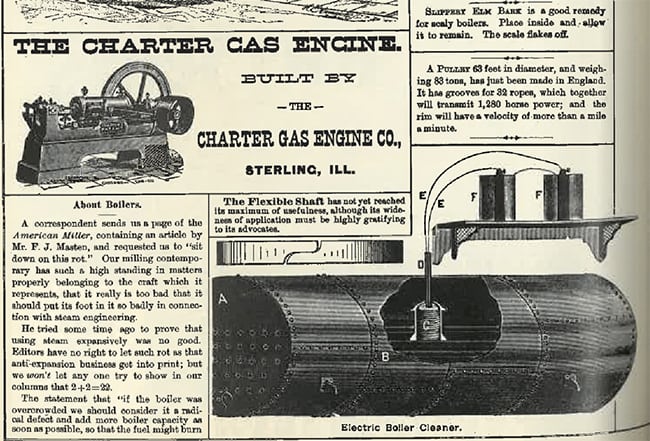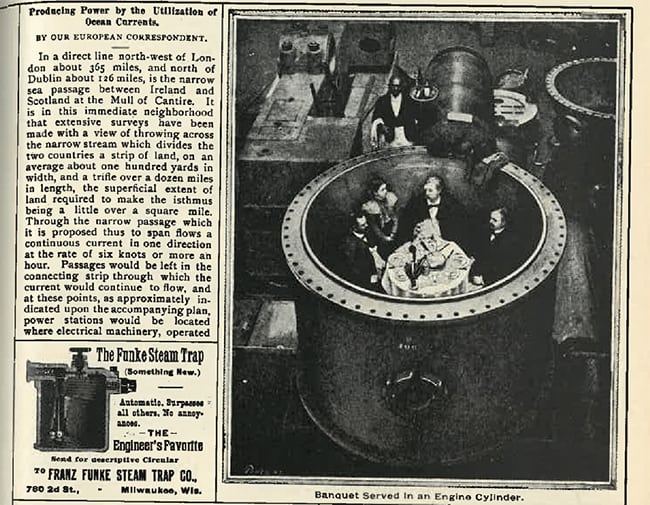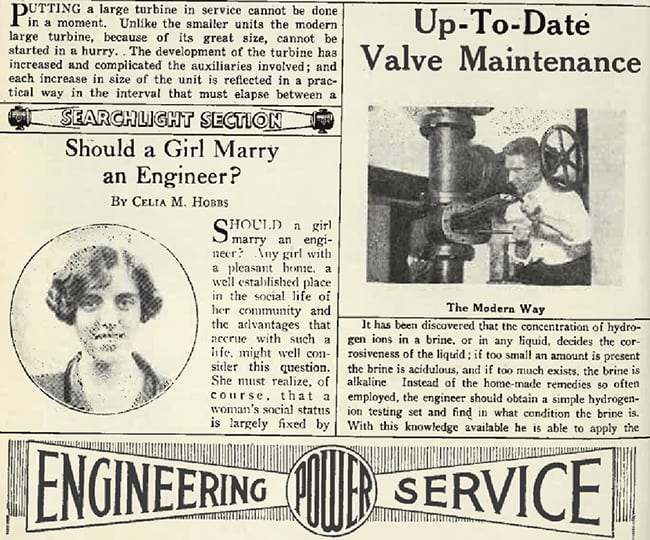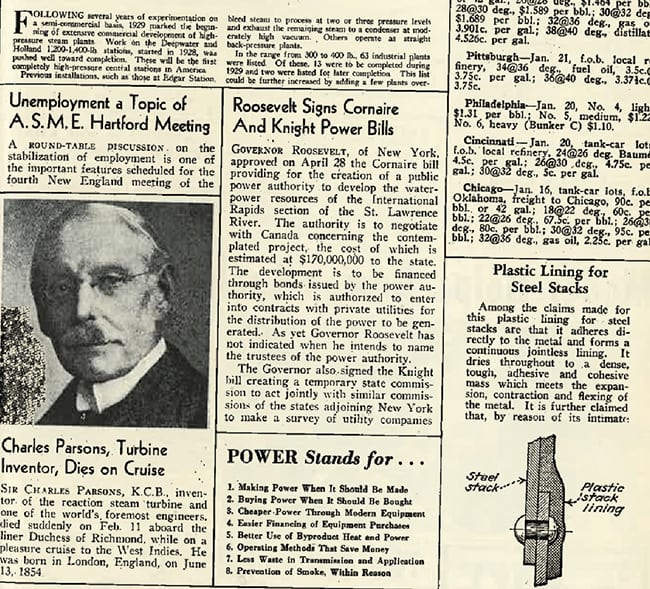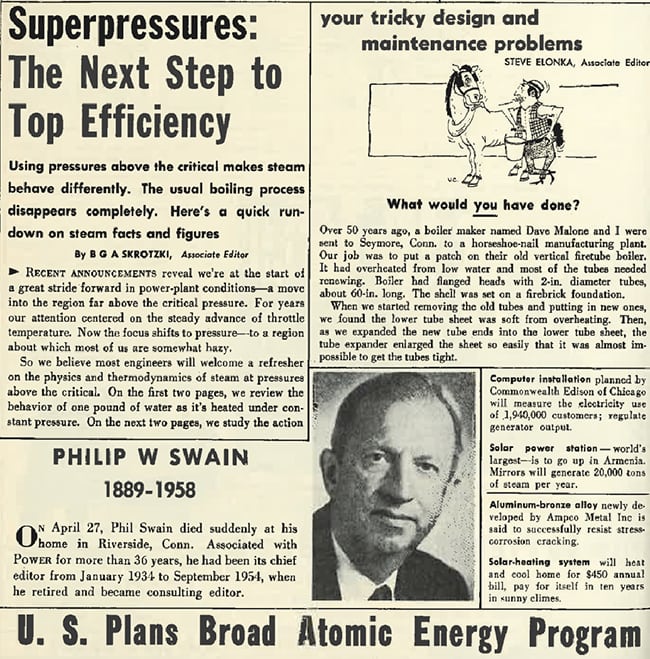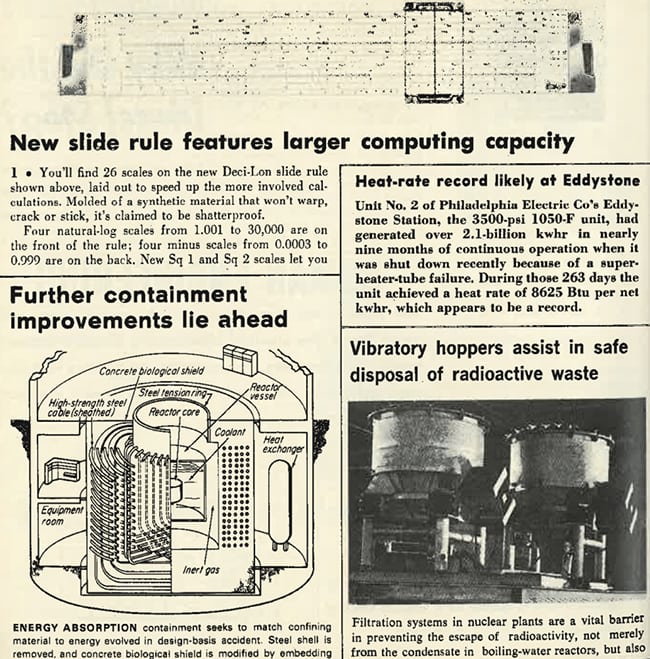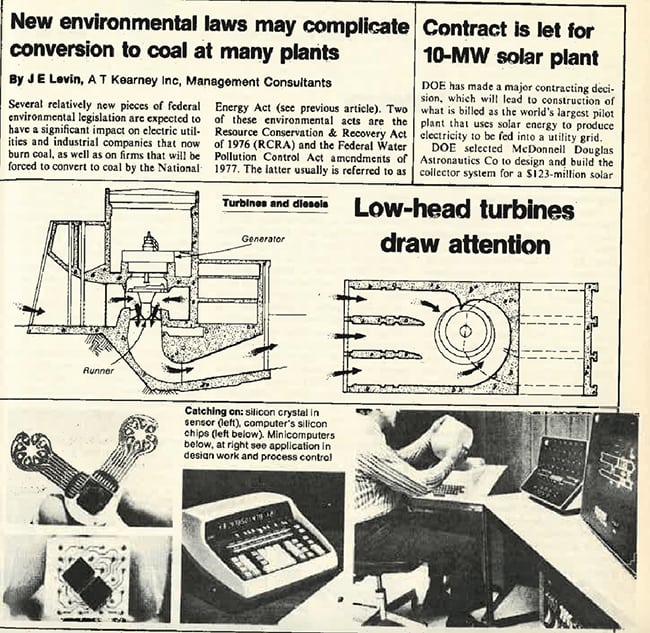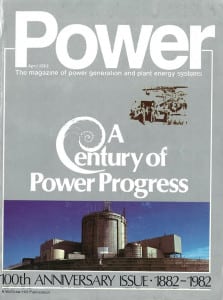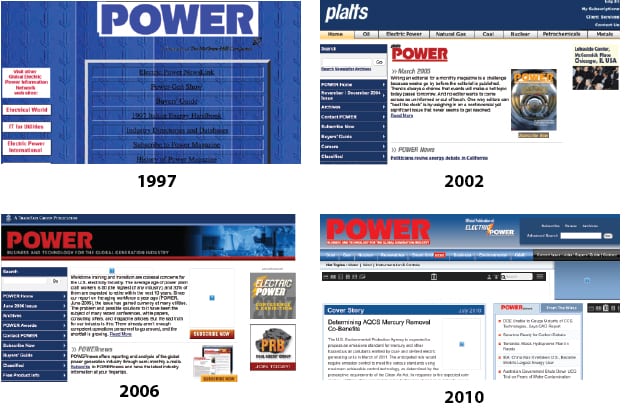135th Anniversary—Excerpts from the pages of POWER (SLIDESHOW)
POWER magazine—the oldest-running trade publication for power generators in the world—has since its establishment in 1882 been a valuable resource for business and technology developments. Here are compelling excerpts from the magazine’s voluminous pages over the 14 decades it has been published. [Scroll down for full content.]
Source: POWER magazine archives. All rights reserved. —Sonal Patel, a POWER associate editor
The 1950s were marked by so many dazzling technical achievements in coal, gas, nuclear, and solar power technology, and POWER’s issues were crowded with important announcements and breakthroughs. One article declares: “Recent announcements reveal we’re at the start of a great stride forward in power-plant conditions—a move into the region far above the critical pressure. For years our attention centered on the steady advance of throttle temperature.” Another fascinating piece describes separate initiatives by General Electric and Westinghouse Electric Corp. to secure federal backing for construction of a large-capacity power reactor. Westinghouse’s full-scale 60-MW plant will cost “tens of millions of dollars,” POWER notes.
In the 1950s, POWER lost one of its longest-running chief editors, Philip Swain. Swain’s 20-year legacy remains part of a remarkable and significant feature of the magazine’s history, which is that it had only five editors-in-chief throughout its first 100 years of publication. So much would have transformed on the power landscape during Swain’s time as chief. During his final decade, as another POWER brief shows, Commonwealth Edison of Chicago—one of the oldest U.S. electric utilities—installed a computer to measure the electricity use of its 1.9 million customers and “regulate generator output.” That same brief notes that a massive solar thermal power station was under development in Armenia.
1880s:
The 1880s were a pivotal decade for the advent of hundreds of power producing component technologies, from boilers to engines. This collection of POWER excerpts from that decade notes: “Slippery elm bark is a good remedy for scaly boilers. Place inside and allow it to remain. The scale flakes off.” Also noted is that, “The flexible shaft has not yet reached its maximum of usefulness, although its wideness of application must be highly gratifying to its advocates.”
As interesting is a scathing rebuke by POWER’s editors of a contemporary grain milling publication’s position on the advancement of steam engineering. The editors were specifically perturbed by an article by one F.J. Masters who had apparently “tried some time ago to prove that using steam expansively was no good.” Acting on a correspondent’s recommendation that the editors “sit down on this rot,” they responded: “Editors have no right to let such rot as that anti-expansion business get into print; but we won’t let any one try to show in our columns that 2+2=22.”
1890s:
This excerpt from the 1890s, from a European correspondent, describes a proposal to harness the power of ocean currents traversing a 12-mile-wide narrow strip of sea between Ireland and Scotland. That project across the Mull of Kintyre never came to fruition—and to this date, deliberations about building even a crossing there between the two countries continue to attract debate.
As curious is this photograph of diners, in black-tie, eating on linen inside an engine cylinder, a butler standing outside waiting to replenish their glasses.
1900s:
In this set of POWER excerpts from the 1900s, the editors note that “The appearance of a new gas or oil engine is almost a daily occurrence, and to pick out points of essential difference in either their design or mode of operation is somewhat difficult.” Another piece points out that a “serious inroad” seems to have been made in the field of reciprocating steam engines. Yet, “For large central-station work the steam turbine has very largely supplanted the reciprocating unit, and the inverted marine type, to which practice was positively trending for large units when the turbine began to assert itself,” it adds.
1910s:
By the 1910s, power generation has become an established industry, and one piece from this decade jots the growing need for “better” engineers: “Not better $900.00 men but $2000; $2500; $3000 Engineers,” it says. “Men who find out things for themselves and fix them. Make yourself that kind of a man.” Within another issue is this tragic illustration of a bursting boiler tube, an incident far too common in those days. This is evident from a major editorial feature from the late 1800s titled “Boiler Explosions This Month.” Without standards and regulations, continuous disasters involving considerable loss of life and property occurred. POWER was a key factor in forming an organization to formulate pressure vessel codes.
Marking a technology milestone, meanwhile, another piece describes the purchase of a 1000-HP, four-cylinder diesel engine—which it says is one of the largest of its type to be erected in the country.
1920s:
While it has always been at the forefront of power generation technology and business matters, POWER’s pages have also chronicled a changing social landscape. Shortly after women won a national right to vote, Ms. Celia Hobbs—sporting a finger-wave bob haircut, a symbol of the modern woman—opined that women seeking a “pleasant home, a well established place in the social life of her community and the advantages that accrue with such a life,” should consider marrying an engineer. While her reasons are outdated, and her piece feels out of place in a prestigious trade publication, it addresses women. We’d like to think it was to appeal to a new female set of POWER readers who joined the larger workforce after World War I, but federal statistics say only 38 women in 1930 worked as electricians or power station operators nationwide (a number that grew to 1,436 by 1940).
1930s:
Excerpts from the 1930s exhibit the despondency of the Depression era, and several pieces record engineering and construction efforts to increase and stabilize employment. POWER’s pages also note the deaths of power pioneers like Charles Parsons, who invented the reaction steam turbine, and inventor Thomas Edison.
One interesting excerpt lists the basic mission of the power sector: That it should make and sell power when necessary; that it should do it cheaply with new technology and easier financing; that it should cull waste with heat and power efficiency, cost-efficient operations, and sound transmission; and finally, that it should prevent “smoke, within reason.” Pieces from the 1930s also increasingly document the sector’s concerns about environmental pollution, noting for example, a growing fly ash problem that shouldn’t be ignored any longer.
In bright spots, however, POWER’s pages continued to highlight technical achievements. As shown here, one piece heralds the “beginning of extensive commercial development of high-pressure steam plants.”
1940s:
The role of engineers in the war effort seems a consistent theme in POWER’s 1940s pages, but so were efforts to ramp up security at power plants. Early in the decade, POWER published a large wall chart titled, “How to Fight the Fire Bomb,” and in another piece, published a photograph of a “bomb snatcher”—a “pair of tongs with semi-cylindrical jaws to enclose the bomb and hold it as in a cup to prevent” a blast.
Another fascinating article predicts the widespread use of “mercury power plants”—facilities outfitted with a mercury vapor turbine developed by General Electric that used a mercury steam cycle and reportedly had a thermal efficiency greater than 50%. General Electric built at least four commercial large mercury plants between 1920 and 1950 in Connecticut, New Jersey, New York, and New Hampshire. Their widespread commercial acceptance was hampered by more cost-efficient and safer ways to improve the steam cycle, however.
1950s:
The 1950s were marked by so many dazzling technical achievements in coal, gas, nuclear, and solar power technology, and POWER’s issues were crowded with important announcements and breakthroughs. One article declares: “Recent announcements reveal we’re at the start of a great stride forward in power-plant conditions—a move into the region far above the critical pressure. For years our attention centered on the steady advance of throttle temperature.” Another fascinating piece describes separate initiatives by General Electric and Westinghouse Electric Corp. to secure federal backing for construction of a large-capacity power reactor. Westinghouse’s full-scale 60-MW plant will cost “tens of millions of dollars,” POWER notes.
In the 1950s, POWER lost one of its longest-running chief editors, Philip Swain. Swain’s 20-year legacy remains part of a remarkable and significant feature of the magazine’s history, which is that it had only five editors-in-chief throughout its first 100 years of publication. So much transpired on the power landscape during Swain’s time as chief. During his final decade, as another POWER brief shows, Commonwealth Edison of Chicago—one of the oldest U.S. electric utilities—installed a computer to measure the electricity use of its 1.9 million customers and “regulate generator output.” That same brief notes that a massive solar thermal power station was under development in Armenia.
Also included in this set of excerpts is a “What would you have done?” piece by Steve Elonka, a POWER associate editor who invented a Marmaduke Surfaceblow fictional series that was to run some four hundred episodes. Read more about Marmaduke in our special 135th anniversary supplement: “Engineering a Legacy: Marmaduke Surfaceblow.”
1960s:
Technology took another leap in the 1960s. This set of excerpts notes advancement in computing capacity, containment improvements, and filtration systems. It also reports a heat-rate record set by Philadelphia Electric’s Eddystone Station, a 3,500-psi, 1,050F unit that generated more than 2.1 billion kWh in nine months of continuous operation. “During those 263 days, the unit achieved a heat rate of 8625 Btu per net kwhr, which appears to be a record,” it says.
1970s:
Some headlines in POWER’s 1970s issues could be published today. The decade was pivotal for renewable power technologies, which experienced a resurgence during the decade. POWER’s pages also chronicle uncertainties posed by many new market and environmental rules. One piece notes that the Resource Conservation and Recovery Act of 1976 and the 1977 Federal Water Pollution Control Act (later reorganized and expanded as the Clean Water Act) could have a “significant impact on electric utilities and industrial companies that now burn coal, as well as on firms that will be forced to convert to coal by the National Energy Act.”
That’s right: At one time, under a law signed by Jimmy Carter in response to the energy crisis of the 1970s, industries and utilities using oil and gas were actually forced to convert to coal.
1980s:
In 1982, POWER magazine celebrated its 100th anniversary. From the very beginning, POWER has kept editorial pace with fast-developing technology, and a market strongly influenced by economic growth. As it had through its first 100 years, during the past 35 years, POWER’s editorial pages reflected the proliferation of new products and scientific advances. It is also a primary outlet for technical papers.
1990s:
In 1997, POWER magazine went electronic, enabling the addition of a large volume of news to the publication’s features and special reports. While the face of POWER’s digital avatar, www.powermag.com, has changed over the past 20 years, POWER’s mission to provide quality business and technology for the global generation industry has not.
2000s:
Since 2006, POWER’s print and digital products have been bolstered by an assortment of multimedia, including infographics, podcasts, video, slideshows, and maps—such as this one from October 2008, which shows coal-fired power plants in the U.S. by capacity and total production costs. Along with this map, the global power landscape has significantly transformed within the past 10 years. For more, stay informed with a subscription to POWER, sign up for its newsletters, POWERnews, COAL POWER Direct, and GAS POWER Direct, or dive into POWER’s archives, which are available at: https://www.powermag.com/publications/.
—Sonal Patel is a POWER associate editor

